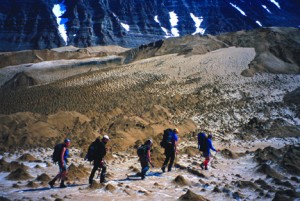Super eruptions are disasters like none other
November 4, 2011
907-474-7468
11/4/2011
The Earth is pocked with giant craters that are reminders of a natural hazard that has happened before and hopefully won’t happen again any time soon, the “super eruption.”
Stephen Self, a volcano researcher from Open University in England, visited Fairbanks to lecture on super eruptions, the last of which happened in 1815. The tropical volcano named Tambora exploded for two days, leaving behind a giant caldera and pumping so much ash and sulfur dioxide into the atmosphere that 100,000 people died the year after the eruption. The ash and gases didn’t kill them, but the volcano’s affect on the atmosphere did.

“1816 temperatures in London were 5-to-8 degrees Celsius cooler,” Self said. “It was the ŒYear Without a Summer’ in the northeastern U.S., a year that inspired people to move west.”
Super eruptions don’t happen often, but they have been much larger than the Tambora eruption. An eruption in about AD 1452 was twice the size of Tambora, and both Long Valley cordera (California) and Yellowstone (Wyoming and Idaho) are the earthly scars of super eruptions that affected large areas with their ashfall and lingering effects on the atmosphere.
“Yellowstone covered a large portion of the Lower 48,” Self said. “If another of these should occur, an entire country could be covered by ash.”
A super eruption could put the brakes on life as we know it, Self said. A big eruption would pump so much ash and particulates into the air that the whole planet would cool by as much as 10 degrees Celsius. Crops would fail and sulfur dioxide would eat holes in ozone. Self said there is basically no way to prepare for a super eruption and it is perhaps foolish to worry about them, but how can a volcanologist not think of them?
“Even though they are very very rare, I think it’s worthwhile to go through the mind exercise of imagining what they might be like,” Self said.
Steve McNutt of the Alaska Volcano Observatory in Fairbanks agreed with Self’s assessment of a super eruption being bad for the business of being a human being.
“If there were an entire season of crop failures worldwide, it would not be pleasant,” McNutt said.
McNutt has looked into finding the precursors of a super eruption. He studied earthquake swarms ‹ numerous internal earthquakes that precede volcanic eruptions ‹ to see if a longer period of swarms related to a larger eruption. Included in his data set was information from the Katmai eruption of 1912, recorded by Japanese scientists who had deployed some of the world’s first seismometers.
Katmai, which created the Valley of Ten Thousand Smokes on the Alaska Peninsula, was the largest eruption of the 20th Century and is one of the few eruptions in modern times large enough for McNutt to consider as representative of a super eruption. Looking at the earthquake swarm data for Katmai, McNutt noticed the volcano had several large earthquakes, as high as magnitude 5.5, before it erupted. That fit with other data that showed that super eruptions would perhaps show their hands with increased earthquake swarm activity before they happen. So, while we may not be able to do much about a super eruption, scientists may be able to see one coming.
“I think it’s unlikely we’d be blindsided,” McNutt said.
This column is provided as a public service by the Geophysical Institute at the University of Alaska Fairbanks, in cooperation with the UAF research community. This column first appeared in 2007.


